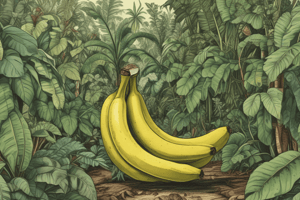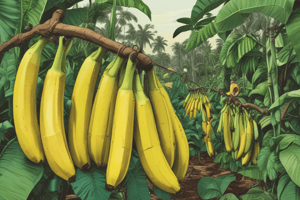Podcast
Questions and Answers
What is the scientific name of the banana plant and why is it considered the world's largest perennial herb?
What is the scientific name of the banana plant and why is it considered the world's largest perennial herb?
The scientific name of the banana plant is Musa acuminata. It is considered the world's largest perennial herb due to its sturdy plant structure, large leaves, and lack of woody tissue.
How are commercially grown bananas propagated and why can't they reproduce through seeds?
How are commercially grown bananas propagated and why can't they reproduce through seeds?
Commercially grown bananas are propagated through division, a process of separating offshoots or 'pups' from the mother plant. They can't reproduce through seeds because they have been cultivated to become seedless.
What are some of the health benefits associated with consuming bananas?
What are some of the health benefits associated with consuming bananas?
Some health benefits associated with consuming bananas include reducing the risk of high blood pressure and stroke, regulating heartbeat, and ensuring the production of hemoglobin in the blood to prevent anemia.
What is the scientific name for the banana plant?
What is the scientific name for the banana plant?
How do commercially grown bananas propagate?
How do commercially grown bananas propagate?
What is the nutritional composition of a banana?
What is the nutritional composition of a banana?
Bananas are classified as a ______ rather than a fruit
Bananas are classified as a ______ rather than a fruit
The most widely consumed banana variety is the ______
The most widely consumed banana variety is the ______
Bananas contain three types of sugars: sucrose, fructose, and ______
Bananas contain three types of sugars: sucrose, fructose, and ______
Flashcards are hidden until you start studying
Study Notes
Banana Plant Scientific Classification
- Scientific name of the banana plant is Musa acuminata.
- It is classified as the world's largest perennial herb due to its tall, non-woody structure and underground rhizome system, which allows for continuous growth over multiple years.
Propagation of Commercially Grown Bananas
- Commercially grown bananas are primarily propagated through vegetative methods, specifically using suckers or tissue culture techniques.
- Bananas cannot reproduce through seeds because most cultivated varieties are seedless due to their parthenocarpic nature, meaning they develop without fertilization.
Health Benefits of Bananas
- Rich in potassium, which supports heart health and regulates blood pressure.
- Contains dietary fiber that aids digestion and promotes gut health.
- Provides quick energy due to its natural sugars, making it an excellent snack for athletes.
Nutritional Composition of Bananas
- Bananas contain essential vitamins such as Vitamin C, Vitamin B6, and various antioxidants.
- They provide approximately 89 calories per 100 grams, consisting predominantly of carbohydrates.
- Bananas contain three types of sugars: sucrose, fructose, and glucose, contributing to their sweet taste.
Classification and Popularity
- Bananas are classified as a berry rather than a traditional fruit due to botanical definitions.
- The most widely consumed banana variety globally is the Cavendish banana, prized for its sweetness and shelf stability.
Studying That Suits You
Use AI to generate personalized quizzes and flashcards to suit your learning preferences.




